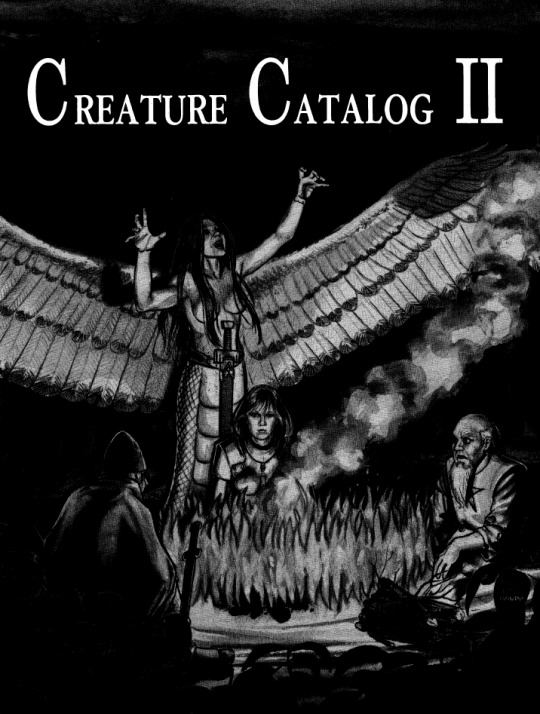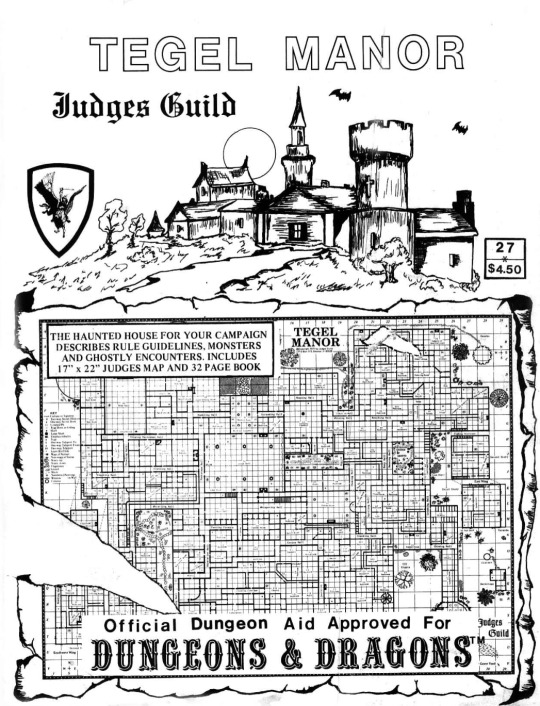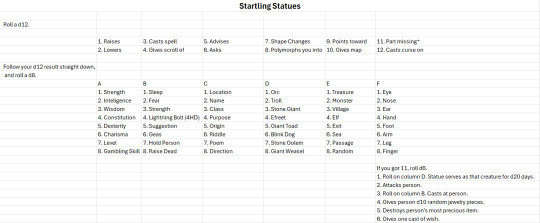#Jennell Jacquays
Text
361. Various Authors - Dragon #94 (February 1985)

Let's start with some sad news, I just learned that TTRPG and Video Gaming pioneer Jennell Jaquays passed away today. We've had some of her work featured here (the illustration for the cover for Dragon #21 for example) but most of her work is still to be covered in the future (she wrote and co-wrote modules for TSR later in the 80s, for example). She was in the hobby from the start, publishing fanzines and unofficial modules for D&D that go all the way back to the mid-70s. With her goes a bit of the history we are covering here.

Moving on to Dragon #94, we have a classic Clyde Caldwell cover wrapping what is a pretty great issue, full of juicy content for D&D fans. Gary Gygax brings us some rules changes for the Ranger class, concerning rules for tracking. Katharine Kerr covers the logistics of food in adventuring and Ed Greenwood gives us the ecology of the Chimera.

If this was all it would be a good issue, but there is more. Fans of Dragonlance will not want to miss Tracy Hickman's two pages on the history of the Knights of Solamnia while the centrepiece of the issue is the Creature Catalog II bringing 16 new monsters designed for AD&D adventures. There's a good variety of beasties here, although no particularly classic monsters. Loads of content here!

13 notes
·
View notes
Text
Pre-G1 Modules, part 4...A - The Judge's Guild Roundup
Part 4a? This is one of those projects that keeps ballooning in scope forever.
Again, keeping with the theme of "trying to not get too historical", Judge's Guild was a group formed by Bob Bledsaw and Bill Owen to release DM aids, in part because then-TSR didn't think it was a viable market. Note that this is Bob Bledsaw Sr., the guy responsible for the nazi incident at Judge's Guild a few years ago was Bob Bledsaw Jr. Anyway, JG was responsible for a lot of materials ranging from setting materials, adventure modules. A lot of luminaries ultimately come from JG, including recently passed legend Jennell Jacquays, so they're a very worthwhile topic to review. I will not talk everything they put out between 1976 and G1 because I'm already planning on touching on (edit: 3 of 6) items today, so we will focus only on their for-sale, non-serial modules.
City-State of the Invincible Overlord (1977)

This is stretching the definition of module -- it's more of a setting book. CSIO is a setting supplement for, yeah, a city state of an invincible overlord. I hope you like maaaaaaaaaaaaaps! Essentially, an overlord stays above and aloof to the factional struggles of the people beneath him, roman emperor-style, and details out a bunch of characters and places within a city. It's, actually pretty good, I think a modern revision of CSIO would probably be pretty fun to play in, especially if you omitted a lot of 1970s gunk (like the frequency of slavery). It has this nice quality where it's much more brief per-location than modern city sourcebooks, but has many many varieties of the same concept. You might want a tavern, and there are so many to choose from. Here's a random assortment of buildings you can find in this book:
A park of sexy statues with a pleasure cult hiding in the rush
A 'fear shop' where the owner will go to ridiculous lengths to scare you
A GILF brothel
The tavern that Fafhrd and the Grey Mouser always go to
A siege engineer you can bribe for promotions

The map is almost, too comprehensive. I'm not sure what % of buildings are described but it's gotta be close to 20%, which is REALLY HIGH by ttrpg city standards. I'd guess that Green Ronin's Freeport is maybe 1% described. The book also has the traditional regulars of a city book (laws, sewer maps, factions) as well as the admittedly novel idea of a full advertising system to acquire hirelings. It, probably didn't merit a full page, but the idea of caring this much about where precisely those hirelings is coming from is kinda novel.
Regardless, this is an adventure module review blog, not a city review blog, so we have done our due diligence and may now proceed.
Tegel Manor (1977)

Oh boy, it's a megadungeon. Here we go. So despite that ominous cover, it's only 30 pages, so it could be worse. The essential schtick of the adventure is that there's a destitute (by noble standards) paladin who owns the deed to an extremely haunted mansion and is desperately trying to pawn the problem off on someone else. You can bully him into helping, but he's a complete coward.

The house is magically fireproofed because adventurers are just like that. A good sign, I think? Surely this won't be a tedious monster closet festival? We have a pretty standard rundown of a town and,

That's one of the most unfortunate names I've ever seen. If I was a dwarf named Cretin Nodcock, I feel like I would also not give a damn about my appearance. Or maybe work on a name change. This adventure really lavishes in its old timey words, we have a paladin described as "poltroonerous" (cowardly), a passing mention of "white wassail" (a mulled white wine), et c. Relatively little is given about the surrounding town and countryside, just enough to get us into the manor asap.
The first floor is a greatest hits of a haunted house. Animated knives, disappearing ghosts, screaming, the walls ooze GREEN SLIME, et c. Here's the stuff (across this entire dungeon) that isn't rote:
A creaky floor that gets so loud that it stuns elves' sensitive hearing while a wall crusher goes off
An animated yellow mold that looks like a sleeping woman
An animated painting of a battle that shoots arrows outward randomly
An animated painting that paints the party, and if it succeeds the party is petrified
Rust monster on flying bed action
A room of opaque gas-filled tubes that contain a variety of people, monsters, objects in animation. I bet the elf lord would have some nice things for their rescuer.
The level of haunting really goes down and it just becomes an assemblage of roughly halloween monsters in increasingly ridiculous patterns. If I was running this, I'd probably shrink the manor down into a greatest hits version of these rooms, because this is a SPRAWLING manor and it's room after room of "there is a wolf, there is a wight, there is a moldering desk". When you think of Gygax going "why would anyone want to buy a module?", this is sticking in my mind. It's not "Dwarven Glory" bland but it IS a never-ending gauntlet of monsters punctuated by silly rooms.

A rare luxury after all the room-by-room shit. Just some good ol' fashioned silliness.
Inexplicably under the house is a further dungeon-dungeon, which is mostly rat tunnels. Happily some of these maps feature little blank lines to mark your revisions from the official map, which is a nice little conceit.

I am always, always, always happy to have a new riddle to throw at my party, although I'm not so good at riddling myself.
Curiously, lich is spelled with an e at the end here, I have no idea how normal this was at the time.

Like most GMs, I have a crippling addiction to random tables for miscellaneous crap. This is a really hard to parse table but I believe how it works is:
Roll a d12 to determine what the statue does from the first list of results
Follow that result vertically down to the array of concepts
Roll a d8 and pick from that vertical list of results
So for example, I rolled d12=5; d8=8. I go to 5 in the first list (Advises), follow it down vertically to the third column of results (the one that starts with Location), and index down to 8 (Directions). My magic statue advises directions to the party. What a nice guy! This table bothers me so bad that I rejiggered it real quickly in excel, because with the benefit of widescreen monitors it's pretty easy to fix:

Tegal Manor wraps with some extra resurrection rules, in case you needed more realism in your magical revivification. I think I prefer it just working, thanks.
Modron (1977)

There's honestly a stunning lack of underwater content in RPGs, I think. Underwater is such a magical location, both experientially and in mythology. One of these days I will set an adventure in one of those sets from the old 1986 Journey to the West TV show, the underwater sea dragon palace ones? They're so fucking cool. Everything is better with underwater dragon palaces.

Right. Modron. Focus.
Modron is another one of those "straddling the line between module and setting book" situations, only much smaller than CSIO. The art all looks like Prince Valliant, which by that sentence alone either means you're going to love or hate it (I hate it). Our titular Modron is a goddess, but also a temple, but also a port town. We will deal with these in order.
Goddess Modron is a river goddess who was worshipped by the town and the temple. She is implied to be, kind of like wonder woman in a weird way? She has to exist underwater, or she dies in 6 rounds (so 6 minutes), which is pretty fucking lame but I too know the struggle of dry skin. She's a fertility goddess (who isn't) and she does d20 years of damage when she lovetaps you. Tragically, she is no longer worshipped in favor of Mitra. COWARDS! LOVE YOUR RIVER/SEA GODDESSES.
Modron's Temple is very, very briefly explained. Essentially, only the oldest people in town know how to find it, via the cellar of the tavern. It's completely underwater, and a lot of mermen hang out there. The head priestess can drain your water! Google says that one love tap would exhaust you, two would probably kill you, and three would definitely kill you. It's implied in this section that a JttW-style Triton Coral Kingdom is, in fact, hanging out off the shoreline somewhere.
Town Modron is your standard raided port town. There was once two gods worshiped here, then it got messed up by raiders and ECONOMICS and some light civil war. It's okay, ya boi Invincible Overlord is sending you a bailout, making him a better autocrat than most living politicians. Apparently they have a pet seamonster who serves the overlord directly? Awesome! We need more pet kaiju in the world.
The actual area-by-area is pretty blasé. The local rulers are varyingly competent (the king is competent but a huge sex pest), there's a guy who takes you on guided tours to, anywhere in the multiverse? Somehow the blacksmith has figured out how to rustproof armor, which will really piss off your rust monsters. The book makes a point to say that the jailor is a particular bastard, so Judge's Guild says ACAB? Unlikely but a very funny concept.
Tragically, we end our adventure without a map of the palace, the temple, the other temple, or anything. I don't believe this is the first supplement to contain Mitra as JG's most famous god (well, Mitra is a real-life god anyhow), but this is certainly the first adventure-ish module to feature him. Dark Tower is quite a ways away!

A poison coral table is, one of those things you would only ever see in early DND. That is so unbelievably specific. The book ends with many such cases, there's a pearl randomizer that doesn't include any fun magic effects or anything, merely linking to Supplement II. Boo!
So originally when writing this, I had intended that part 4 be a whole unit, but then I realized that I was going to have to include these semi-adventures in the roundup. So to my great shame, we will continue this later.
7 notes
·
View notes
Text

The seasons are turning, but we’re staying the course and cranking out art, here In the studio with Brad McDevitt! This week, we will re-visiting the fantastical world of Jennell Jacquays’ Thracia!
Tune in (11/6/2023) from 7-8:45 EST for the fun!
twitch_live
As usual, Brad will be taking questions, answering them, and responding to points spent with fun facts, riddles and enough bad puns to get me boo’ed offstage at any nightclub in the land!
0 notes
Text
A Tale from the Caverns of Thracia
So I was inspired to create a megadungeon open table game for dungeons and dragons. After reading through various posts on The Alexandrian about the style of play, I decided to give it a go. I had tried somewhat open table things in the past, though they failed through poor planning on my behalf. I also considered running a west marches game, but felt like a megadungeon would be better; rather than key a large hex map, I “only” keyed two levels of a dungeon. In addition, I decided to run the Caverns of Thracia, written by Jennell Jacquay for the judges guild, to save time on making a dungeon from scratch.
Armed with a key, random tables galore, and redrawn maps (complete with dynamic lighting for that dungy dungeon feel), I informed my d&d friends and organized a game. I have decided to keep a log of the various delves we go on, and perhaps I’ll go into more detail of some more behind the screen stuff too. But for now, the tale of our first delve into the Caverns of Thracia.
Delve 1
For the first expedition to the caverns, we had a party of three brave souls; Athoz the leonin fighter, Iados the aasimar monk, and the warlock Nieven (starting at 2nd level). Before leaving, they rolled up for rumours, with Athoz learning of bat nests in the caverns, so best keep light down not to startle them. He was also told to keep an eye out for strange flora, and an ear out as a strange and loud roar that was heard coming from the caves a few days ago. Iodas learnt that someone who called themselves “the Minotaur King” was leading the beastfolk, and minotaurs are occasionally seen amongst the ranks of lizardfolk and gnolls. They shared their rumours opening, and were ready to go exploring.
Reaching a large stone foundation where a temple or building complex once stood, they found a clay tablet written in a strange language. Unable to decipher it, they descended the wide steps into the caverns. They went without a light, which proved useful as they walked past the huge array of bats living in the starting rooms without disturbing them too much.
The wide entrance room had two exits, right and forward (a left passageway was blocked by a cave in). They went forward, careful not to slip on the inches of bat guano that had accumulated over time. They entered a pillared corridor, again full of bats, noticing a shattered statue at the far end as well as a fissure in the western wall. The fissure opened up to a cavern below, past the reach of their darkvision. As they were debating what to do to try and estimate the depth, Athoz and Iodas heard murmuring to the north; by the statue were a pair of doors, one spiked shut, the other one apparently with someone behind. Iodas listened carefully. While he couldn’t understand the language, they seemed cautious and were debating what to do next. They also sounded reptilian, meaning they were perhaps lizardfolk or similar.
Meanwhile, Athoz and Nieven removed the spike from the other door and had a look inside. It was a nest of large red centipedes, writhing around angry and hungry (4 swarms of insects to be precise, nothing to sneeze at for some level 2’s). Athoz debated spiking the door shut, but Nieven wanted a fight, so combat broke out. A casting of bonfire in the doorway kept the centipedes at bay as they released a volley of missiles into the horde, though eventually some braved the flames to reach food. Athoz was hit with a critical hit, taking 22 damage, his exact health (8d4 is a lot!).
As Iodas dragged away the fighter and restored him with magic (they are sun soul monk I believe), Nieven blasted away with an eldritch blast. The centipedes were emboldened by their success, and they braved the flames to flood the party. However a cone of fire from burning hands killed enough to send the survivors scattering. Those who could not escape into the fissure were finished off in the nest. And with that the room was cleared.
Meanwhile, the occupants of the other room were holding firm (a reaction roll came up as “passive”, so they were waiting to see what happened). They decided to search the nest and get out, rest up, and return later. Prodding through the nest dug up some trinkets; a brass flute, a box with a pair of copper figurines inside, and some sort of arcane stamp or symbol. Not much, but something. Spiking the other door shut, they left.
They rested for an hour outside, Athoz restoring his hit points and Nieven his spells. Iodas had a look at the other ruined buildings, well their foundations at least, and spotted a more intact structure off in the distance, some 60 or so feet from the main stairs. Investigating, it was a low stone building sealed with a thick wooden door, barred with bronze. The party convened to assess the door. No one had thieves’ tools and the lock was far too complex to dislodge with a claw or dagger. So they battered it down with crowbar and maul, and opened up a narrow staircase that led down.
The corridor was narrow, 5 feet to be precise, so they were forced into a single line. At a turn they could see that the corridor seemed to open up into a cave, though there was no floor as they seemed to be at the top end of it. Instead, a rope bridge led across to the rest of the corridor, where they could see a light and a guard, standing there in hoplite-like amour (toughened linen breastplate, spear, shield…). They called out, asking the party to state their business, and didn’t seem too amused at their response of adventurers/explorers. He called for reinforcement, and behind him a door opened up, revealing two more soldiers as well as two robed figures. As the party dithered on what to do (no one wanted to cross the rope bridge), the guard prepared to huck a javelin, though was halted by a robed man who called out to the party.
The man looked cleric-like, with long black robes, an amulet around his neck, and face painted somewhat pale and with dark rings around his eyes and black tears falling from them. He raised his tattooed hands and called out to the party with a certain cheer, announcing that the place was a sacred place of “the Dark One” and offered them safety if they wished to cross and learn more.
A quick religion check later revealed this Dark One to be some sort of god of death, fate, or mortality, worshipped by some of the local Thakian clans and petty kingdoms. They weren’t well known, and definitely not a formal religion in other parts of the world. They decided to reject the offer, and instead leave (with the priest calling “come back if you want to learn more and sate your curiosity!” at them as they left). Hopefully they won’t be too mad about the door.
Returning to the main staircase, they returned to the pair of doors and the centipede scuffle. The spiked door had been broken down, and whoever inside was gone. Inside were remains of a camp, and some of the centipede corpses had disappeared too. They decided to check out the room, namely the “ornate wall paintings” I described. Iodas found a marble head in the remains of a statue that was in remarkable door continuation, while Nieven discovered a secret door hidden behind a stone panel. He decided to blast it with an eldritch blast, failing, and Athoz stepped up to pry it open with a crowbar and some lifting.
It led to part way along a corridor. To the left, the corridor continued into darkness, though of more pressing concern was a gnoll warrior who, alerted by the loud banging of the blast, was growling at them. He was in front of a door, and others could be seen and heard behind them.
Randomness helped them here though, as while this standoff was happening, an alarm cry from further away followed by a “charge!” in Thakian. This kicked off a three way combat between the party, the gnoll guards, and a band of Thakian hoplites who had entered the caverns to drive off the gnolls. The Thakians seemed allied with the priests from earlier and, in a case of “the enemy of my enemy is my friend”, joined forces temporarily to take down the gnolls. Five gnoll warriors, two gnoll archers, five hoplites, and three adventurers. Athoz was downed at one point by arrows, and Nieven almost met the same fate was it not for a hellish rebuke that annihilated the offending archer. The hoplites protected Athoz while the gnolls were hacked down, the survivors surrendering as they were trapped in the guard room.
The sergeant leading the hoplites, a woman with the same black facial markings of the priests, spoke with the party on how to divide the spoils. She was not terribly happy to deal with adventurers, seeing the caverns as belonging to her people. Iodas and Nieven argued that they could be of use to each other, as the party could help them in fighting off the gnolls who had made their lair in the Thakians’ sacred places. She told them to speak to the priests if they wanted to work further with them, and hashed out a deal for the immediate spoils. The party could take the material loot, and she the captives (for the priests to interrogate). The party argued to take one of the captives, to ask them for information on the caverns and perhaps convince them to into joining them. The sergeant agreed, and healed Athoz to 1 hit point through some lay on hands. The hoplites left, the party hoovered up what trinkets and coins the gnolls had as well as all the weapons, and left the caverns.
While they didn’t level up, they are most of the way there. The marble head was worth the most, and the trinkets added up eventually. They also now have a captive gnoll, who Iodas is planning to treat well and try to convince into helping them navigate the caverns in the future. While the rolls haven’t been made yet, it’ll probably be likely if Iodas shows he is the stronger leader, and will reward them with gold for their service. I’m using hireling/companion morale rules and such, so they might start with a low morale, but the gnolls of the caverns are raiders and tend to follow the strongest. Those who follow the minotaur king have little concern over nations and family bonds. Other gnolls perhaps, though not these particular ones.
All in all, I’m really happy with how things went. It was my first time running for the open table, and while some streamlining could help (namely printing off all my random tables and dungeon key) I am excited to play again.
2 notes
·
View notes
Text
i was reading an article on early female gamers and there were a lot of interesting bits in it, but one that really stands out is in a passage about the variety of ways in which men tried to adapt the rules for female characters (lower strength, higher charisma, weird seduction rules, etc.). one section of it reads
An article in the pages of Paul Jaquays’s fanzine The Dungeoneer entitled “Those Lovely Ladies” reinvented the Fighting-man, Magic-user, and Cleric classes for women as “Valkyries,” “Circeans” and “Daughters of Delphi,” respectively. It retained the Charisma stat and awarded women a blanket Charisma bonus, though the Charisma of women suffered if their Strength was too high. This piece too received pushback from a female reader, Judith Preissle Goetz, who concedes that “women have higher charisma as far as men are generally concerned,” but observes, ”you have ignored the complementary phenomena that men have higher charisma as far as most women are concerned.”
but a commenter on the article notes that in the past decade, jaquays has come out as a lesbian and transwoman. which really. just adds a lot of layers to everything happening right here
#for the inclined her name is jennell jacquays#and shes done a lot of various stuff in tabletop and computer games
0 notes
Photo

Jennell Jaquays (b. 1956) is an artist and designer of video games and table-top RPGs. She has worked on immensely popular games such as Dungeons & Dragons, Age of Empires and Quake.
She contributed artwork for many beloved games, and designed arcade conversions for others, such as Pac-Man or Donkey Kong. She is a trans woman and the creative director of the Transgender Human Rights in Seattle. Her activism efforts led to the banning of conversion therapy for minors in the United States.
#born on this day#amazing women#jennell jacquays#video games#women in video games#trans#lgbt rights#trans rights#feminist#feminism
247 notes
·
View notes